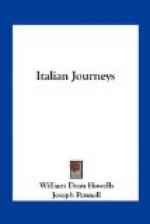Unhappily the day being rainy, Venice did not spring resplendent from the sea, as I had always read she would. She rose slowly and languidly from the water,—not like a queen, but like the gray, slovenly, bedrabbled, heart-broken old slave she really was.
IV.
BASSANO.
I have already told, in recounting the story of our visit to the Cimbri, how full of courtship we found the little city of Bassano on the evening of our arrival there. Bassano is the birthplace of the painter Jacopo da Ponte, who was one of the first Italian painters to treat scriptural story as accessory to mere landscape, and who had a peculiar fondness for painting Entrances into the Ark, for in these he could indulge without stint the taste for pairing-off early acquired from observation of local customs in his native town. This was the theory offered by one who had imbibed the spirit of subtile speculation from Ruskin, and I think it reasonable. At least it does not conflict with the fact that there is at Bassano a most excellent gallery of paintings entirely devoted to the works of Jacopo da Ponte, and his four sons, who are here to be seen to better advantage than anywhere else. As few strangers visit Bassano, the gallery is little frequented. It is in charge of a very strict old man, who will not allow people to look at the pictures till he has shown them the adjoining cabinet of geological specimens. It is in vain that you assure him of your indifference to these scientific seccature; he is deaf and you are not suffered to escape a single fossil. He asked us a hundred questions, and understood nothing in reply, insomuch that when he came to his last inquiry, “Have the Protestants the same God as the Catholics?” we were rather glad that he should be obliged to settle the fact for himself.
Underneath the gallery was a school of boys, whom as we entered we heard humming over the bitter honey which childhood is obliged to gather from the opening flowers of orthography. When we passed out, the master gave these poor busy bees an atom of holiday, and they all swarmed forth together to look at the strangers. The teacher was a long, lank man, in a black threadbare coat, and a skull-cap—exactly like the schoolmaster in “The Deserted Village.” We made a pretense of asking him our way to somewhere, and went wrong, and came by accident upon a wide flat space, bare as a brick-yard, beside which was lettered on a fragment of the old city wall, “Giuoco di Palla.” It was evidently the playground of the whole city, and it gave us a pleasanter idea of life in Bassano than we had yet conceived, to think of its entire population playing ball there in the spring afternoons. We respected Bassano as much for this as for her diligent remembrance of her illustrious dead, of whom she has very great numbers. It appeared to us that nearly every other house bore a tablet announcing that “Here was born,”




